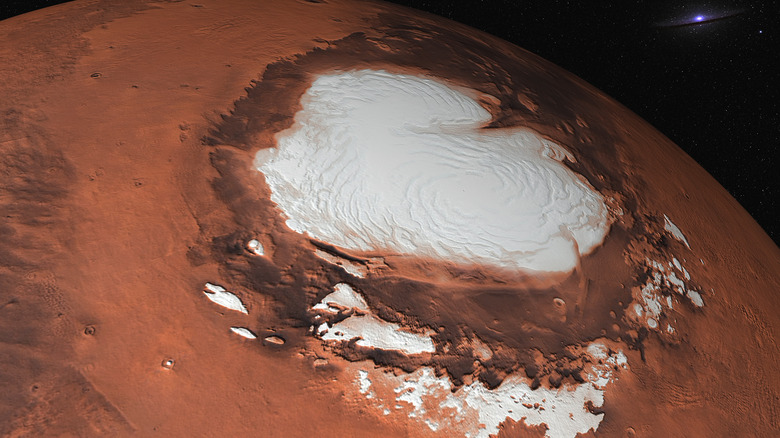New Discovery Challenges What We Know About Water On Mars
If you visited Mars today, you'd find a dry, inhospitable desert. But billions of years ago, Mars was very different, and may even have looked a lot like Earth (via NASA). Researchers think that it had abundant liquid water on its surface, which formed rivers, lakes, and even oceans. In fact, the Perseverance rover is currently exploring the dried-up bed of an ancient lake, as this is a place that could once have hosted life (via MIT).
Today, there is very little water on Mars. There are regions where water ice is present, such as in craters and near the poles (via ESA). And there is thought to be water ice beneath the planet's surface (via NASA). But liquid water is absent, which will be a challenge for future explorers there. However, researchers disagree about exactly how long there was water on the surface. Now, new research using data from China's Zhurong rover suggests that the water might have hung around for longer than previously thought.
Researchers from the Chinese Academy of Sciences looked at data from the rover's microimaging camera and two spectrometers, which analyze the composition of samples by looking at what wavelengths of light they absorb. They found the presence of hydrated minerals in the Mars samples, meaning that the minerals formed in the presence of water. They also found material called duricrust in layers, which forms when there is water present.
A timeline for water on Mars
Previously, the assumption had been that water was present on Mars up until around three billion years ago. However, this timeline has been challenged by recent findings, such as data from NASA's Mars Reconnaissance Orbiter which found indications in the form of salt minerals that there could have been water present as recently as two billion years ago (via NASA).
The research using data from the Zhurong rover seems to support the concept of water being present until more recently than previously thought. It collected data from the Utopia Planitia region of Mars and identified hydrated sulfate/silica materials, which give rocks a bright color.
In addition, the fact that these rocks were found on the surface is interesting, because it suggests the presence of ground ice (via phys.org). This could be a useful resource for future crewed missions to Mars, which will require large amounts of water.
Water is important for crewed missions not only so that astronauts have something to drink, but also for use as rocket propellant for launching off the surface. Water is too heavy to bring along on a rocket mission in large quantities, so astronauts will have to find a source of water on Mars (via Digital Trends).
While there is plenty of water ice accessible on the surface around the planet's poles, most crewed mission plans are looking to send astronauts to regions of the planet nearer to the equator. That means that astronauts will probably have to either bake minerals to extract the water from them or find a source of ice to melt to make the water they need.
